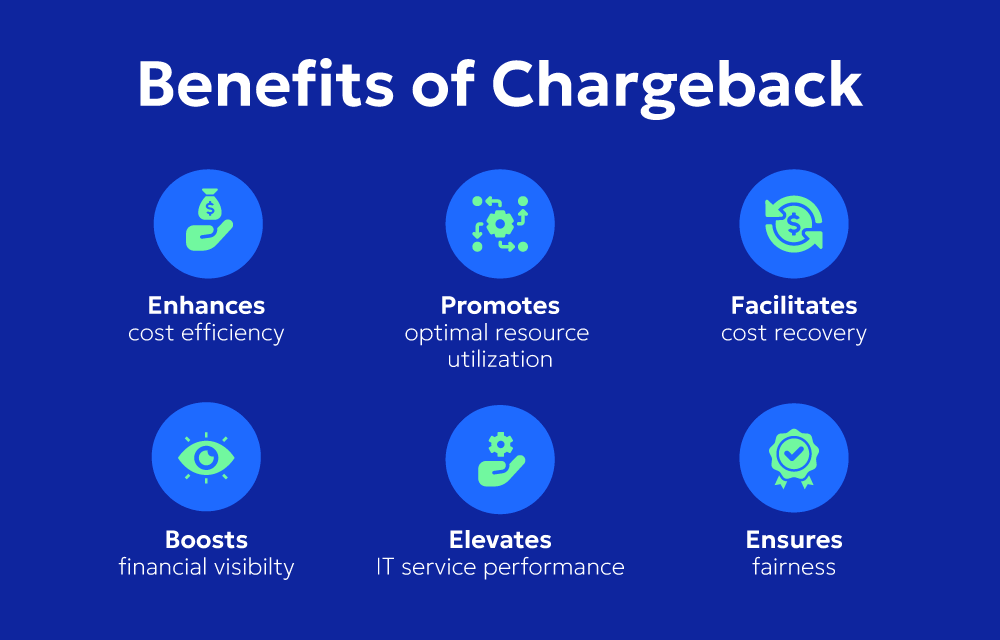What is chargeback in cloud computing?
Chargeback in cloud computing involves the tasks of attributing cloud costs to specific stakeholders, providing transparency and accountability for resource consumption.
Benefits
- Cost Accountability: Encourages responsible resource usage by making stakeholders accountable for their consumption.
- Resource Optimization: Promotes efficient resource allocation and usage by incentivizing cost-conscious behavior.
- Budget Management: Facilitates better budget management by providing visibility into departmental or project-specific spending.
Challenges Involved in the Chargeback Process
- Complexity of Cost Attribution: Determining precise usage and cost allocation for each user, department, or project can be intricate, particularly in multi-tenant environments with shared resources.
- Granularity of Tracking: Achieving fine-grained tracking of resource usage and costs at the level of individual users or applications requires robust monitoring and reporting capabilities.
- Accurate Cost Modeling: Developing precise cost models that reflect the true cost of cloud resources and services, including factors such as variable pricing, discounts, and reserved instances, can be challenging.
- Data Accuracy and Integrity: Ensuring the accuracy and integrity of usage data is crucial for reliable chargeback calculations. Issues such as data discrepancies, missing data, or inaccurate metering can lead to errors in cost attribution.
- Policy Enforcement: Enforcing chargeback policies and ensuring compliance with organizational rules and regulations requires clear guidelines and mechanisms for tracking and enforcing usage limits.
Use Case Examples
- Retail Company:
Business Case: A retail company operates multiple e-commerce websites catering to different regions. Each website is managed by a separate business unit responsible for marketing, sales, and operations. By implementing chargeback, the company allocates cloud infrastructure costs based on the resource consumption of each website. For example, the North America website might be charged for the cloud resources used for handling customer transactions and inventory management, while the Europe website might be charged separately for its operational needs. This allows the company to accurately track and allocate costs, optimize resource usage, and maintain accountability across different business units. - Financial Institution:
Business Case: A financial institution offers various online banking services, including account management, transactions, and customer support. To ensure cost transparency and accountability, the institution implements chargeback for its cloud infrastructure expenses. Each department within the institution, such as retail banking, corporate banking, and IT operations, is allocated a portion of the cloud costs based on their usage. For instance, the retail banking department might be charged for the cloud resources used for hosting customer-facing applications and handling transaction processing, while the IT operations department might be charged for infrastructure management and maintenance. This enables the institution to accurately track IT spending, allocate costs to the appropriate departments, and optimize resource utilization based on business needs. - Technology Startup:
Business Case: A technology startup develops and operates a software-as-a-service (SaaS) platform for project management and collaboration. As the company grows and onboard more customers, its cloud infrastructure costs increase accordingly. To ensure cost transparency and align expenses with revenue streams, the startup implements chargeback for its cloud usage. Each customer subscription is charged based on the resources consumed by their respective instances of the SaaS platform. For example, a large enterprise customer with a high volume of users and data storage requirements might be charged a higher fee compared to a small business with fewer users and lower usage levels. This allows the startup to accurately track the cost of serving each customer, optimize resource allocation, and make informed pricing decisions to maximize profitability.
How to Handle Chargebacks
- Establish Clear Cost Allocation Methodologies:
Define transparent methodologies for allocating costs to departments or projects based on resource usage. - Implement Automated Tools and Processes:
Deploy automated FinOps tools and processes to track resource usage and accurately allocate costs, minimizing manual effort and errors. - Conduct Regular Reviews:
Regularly review chargeback data and processes to ensure fairness, accuracy, and alignment with organizational objectives. - Visualize and Deliver Chargeback Usage:
Develop visualization tools or dashboards to provide stakeholders with clear insights into their cloud resource usage and associated costs, facilitating informed decision-making and cost optimization.
By effectively managing chargeback processes and implementing transparent cost allocation mechanisms, organizations can promote accountability, optimize resource usage, and ensure efficient cost management in cloud computing environments.



